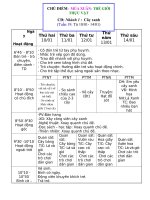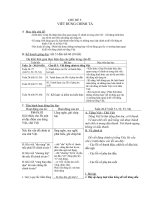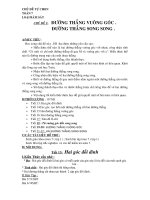BÀI GIẢNG CHỦ ĐỀ MIỄN DỊCH
Bạn đang xem bản rút gọn của tài liệu. Xem và tải ngay bản đầy đủ của tài liệu tại đây (864.24 KB, 93 trang )
Immunochemical Methods in the Clinical
Laboratory
Roger L. Bertholf, Ph.D., DABCC
Chief of Clinical Chemistry & Toxicology, UFHSC/Jacksonville
Associate Professor of Pathology, University of Florida College of Medicine
Name The Antigen
ASCP/Bertholf
Early theories of antibody formation
•
Paul Ehrlich (1854-1915)
proposed that antigen
combined with pre-existing
side-chains on cell surfaces.
•
Ehrlich’s theory was the
basis for the “genetic
theory” of antibody
specificity.
The “Template” theory of antibody
formation
•
•
Karl Landsteiner (1868-1943) was
most famous for his discovery of the
A/B/O blood groups and the Rh
factor.
Established that antigenic specificity
was based on recognition of specific
molecular structures; he called these
“haptens”; formed the basis for the
“template” theory of antibody
formation.
Aminobenzene Sulphonate, a Hapten
NH2
NH2
NH2
SO3
SO3
SO3
Ortho
Meta
Para
Classification of immunochemical methods
• Particle methods
– Precipitation
• Immunodiffusion
• Immunoelectrophoresis
– Light scattering
• Nephelometry
• Turbidimetry
• Label methods
– Non-competitive
• One-site
• Two-site
– Competitive
• Heterogeneous
• Homogeneous
Properties of the antibody-antigen bond
• Non-covalent
• Reversible
• Intermolecular forces
– Coulombic interactions (hydrogen bonds)
– Hydrophobic interactions
– van der Waals (London) forces
• Clonal variation
Antibody affinity
Ab + Ag ↔ Ab • Ag
[ Ab • Ag ]
Ka =
[ Ab][ Ag ]
Precipitation of antibody/antigen
complexes
• Detection of the antibody/antigen complex depends
on precipitation
• No label is involved
• Many precipitation methods are qualitative, but
there are quantitative applications, too
Factors affecting solubility
•
•
•
•
Size
Charge
Temperature
Solvent ionic strength
Precipitate
The precipitin reaction
etc.
Zone of equivalence
Antibody/Antigen
Single radial immunodiffusion
Ag
Single radial immunodiffusion
r
r ∝ [ Ag ]
Double immunodiffusion
Örjan Ouchterlony
Developed double immunodiffusion technique in 1948
Double immunodiffusion (Ouchterlony)
Quantitative double immunodiffusion
S3
S4
P
S2
S5
S1
Electroimmunodiffusion
• Why would we want to combine immunodiffusion
with electrophoresis?
– SPEED
– Specificity
• Carl-Bertil Laurell (Lund University, Sweden)
– Laurell Technique (coagulation factors)
– “Rocket electrophoresis”
Electroimmunodiffusion
+
-
Immunoelectrophoresis
• Combines serum protein electrophoresis with
immunometric detection
– Electrophoresis provides separation
– Immunoprecipitation provides detection
• Two related applications:
– Immunoelectrophoresis
– Immunofixation electrophoresis
Immunoelectrophoresis
α-human serum
Specimen
+
Immunoelectrophoresis
-
+
P
C
γ
P
α
C
µ
P
κ
C
λ
Immunofixation electrophoresis
SPE
IgG
IgA
IgM
κ
λ
Particle methods involving soluble
complexes
• The key physical property is still size
• Measurement is based on how the large
antibody/antigen complexes interact with light
• The fundamental principle upon which the
measurement is made is light scattering
• Two analytical methods are based on light
scattering: Nephelometry and Turbidimetry
Light reflection
Molecular size and scattering
-
+
-









